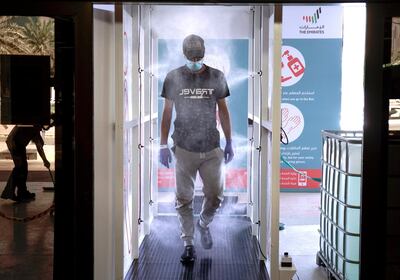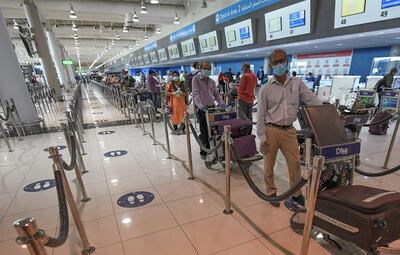It has been more than 100 days since the UAE announced its first cases of Covid-19: a family of four, from Wuhan, China.
Since then, what has gone from an unknown virus, understood to have originated from a wet market, to a full-blown pandemic responsible for the deaths of hundreds of thousands of people.
And the path ahead is yet uncertain with experts saying Covid-19 could continue to stalk for the world for the foreseeable future, unless a way is found to eradicate it.
A vaccine is likely the best hope in doing this but that could be more than a year away, if not longer. And it would take time to roll that out to enough people to achieve herd immunity.
So what could life be like going forward?
This will be our life for the foreseeable future, even for the next couple of years, perhaps
Researchers at Harvard University have said some form of social distancing could be required until 2022.
This is because, despite restrictions taming outbreaks in some countries, any significant relaxation would lead to a surge in new cases that could overwhelm healthcare systems.
“We are trying to flatten the curve. That doesn’t mean we are getting rid of the pandemic,” said Dr Ravi Arora, a specialist in internal medicine at NMC Speciality Hospital Abu Dhabi.
“It means it will be distributed over time, rather than being clustered over a very short period. This is something which is paramount for people to understand.”
Governments walk a tightrope between relaxing restrictions to restart their economies with the effect that would have on the number of infections.
Strict measures on movement aim to keep the number of infections below 1 to 1 in the hopes that, eventually, cases will peter out. To do this, social distancing will likely need to continue for a while.
Wuhan was a case in point. When the city was released from lockdown recently, life did not return to how it was. It reverted to a “new normal”. This included frequent temperature testing of staff in offices and physical distancing measures such as partitions between tables.
Even schools, which returned last week, have changed. Children in Wuhan are required to wear masks and walk in single file past thermal scanners.
It is not clear how schools would change in the UAE, if at all, when pupils return to hallways, but the reopening of malls, offices and restaurants offered a clue on how some aspects of life could be for the foreseeable future.
Shop and restaurant capacities have been capped at 30 per cent to ensure there is enough room to practice social distancing.
Whether that could change going forward would likely depend on the number of cases, said Dr Arora.
“I think the limitations should improve over time but it’s very hard to predict – 30 per cent is a number that at the moment seems right,” said Dr Arora.
“We may go down to 10 per cent or go up to 50 per cent, depending on the numbers."
Another feature that could be here to stay are disinfection gates at entrances to public areas, including malls, bus stations and other buildings.
They were used widely in Wuhan to stem the spread of the virus and one entrepreneur in the UAE has banked on them becoming ubiquitous here, too.
“After 9/11 metal detectors became the norm. They were in hotels,” said Husam Zammar, who owns Guard ME.
“In the near future, these gates will also be everywhere. And shoppers will choose stores with them.”
He said his factory was now making 20 gates a day. And it is just one of a number of similar companies working in the space in the UAE.
“We discovered the market was really thirsty for this kind of product, so we increased our capacity from three every day, to five, then to 10 and to 20,” said the Syrian entrepreneur.
Dubai Future Foundation is also working on producing technologies that may become part of daily life.
“Dubai Future Labs is working on testing and manufacturing medical appliances such as face masks using 3D printing technologies, prototyping ventilators, and artificial intelligence to support the efforts of health authorities,” said Khalfan Belhoul, the foundation’s chief executive.
Many measures in place across the UAE, such as the nightly disinfection drive, requirement to wear masks and observe social distancing, are expected to continue until further notice.
But one day, in the not too distant future, the UAE could open its borders again, having shut them to all but Emiratis wishing to return home, in March. Already, flights carrying UAE residents who were stranded abroad when planes were grounded have begun operating.
It is not known when the country’s borders will reopen for commercial flights but the experience of flying will likely be different going forward.
Last week, The International Air Transport Association, the body representing global airlines said it supported passengers wearing masks onboard to protect them against the virus.
Iata's medical advisor, David Powell, said face coverings would be part of a range of measures including screening passengers before flying to make sure they did not have a fever, plus enhanced cleaning procedures that would allow flying to restart safely.
However, it did not support a plan to leave the middle seat empty, after its chief economist said most airlines will not be able to make money this year if a third of the seats are removed.
Nevertheless, doctors said the use of masks generally could control transmission of the virus.
“There are good statistics on that. If there is a patient who is spreading the virus and wearing a plain mask, and the people around them are wearing a mask, you can reduce transmission from 80 per cent to 90 per cent, which is pretty good actually,” said Dr Arora.
If you add in two metre social distancing as well, protection rose to around 95 per cent.
“We will have to wear masks and we will probably have to wear gloves and avoid large gatherings. We are going to have virtual concerts to virtual meet-ups,” said Dr Arora.
“This will be our life for the foreseeable future, even for the next couple of years, perhaps."
PROVISIONAL FIXTURE LIST
Premier League
Wednesday, June 17 (Kick-offs uae times) Aston Villa v Sheffield United 9pm; Manchester City v Arsenal 11pm
Friday, June 19 Norwich v Southampton 9pm; Tottenham v Manchester United 11pm
Saturday, June 20 Watford v Leicester 3.30pm; Brighton v Arsenal 6pm; West Ham v Wolves 8.30pm; Bournemouth v Crystal Palace 10.45pm
Sunday, June 21 Newcastle v Sheffield United 2pm; Aston Villa v Chelsea 7.30pm; Everton v Liverpool 10pm
Monday, June 22 Manchester City v Burnley 11pm (Sky)
Tuesday, June 23 Southampton v Arsenal 9pm; Tottenham v West Ham 11.15pm
Wednesday, June 24 Manchester United v Sheffield United 9pm; Newcastle v Aston Villa 9pm; Norwich v Everton 9pm; Liverpool v Crystal Palace 11.15pm
Thursday, June 25 Burnley v Watford 9pm; Leicester v Brighton 9pm; Chelsea v Manchester City 11.15pm; Wolves v Bournemouth 11.15pm
Sunday June 28 Aston Villa vs Wolves 3pm; Watford vs Southampton 7.30pm
Monday June 29 Crystal Palace vs Burnley 11pm
Tuesday June 30 Brighton vs Manchester United 9pm; Sheffield United vs Tottenham 11.15pm
Wednesday July 1 Bournemouth vs Newcastle 9pm; Everton vs Leicester 9pm; West Ham vs Chelsea 11.15pm
Thursday July 2 Arsenal vs Norwich 9pm; Manchester City vs Liverpool 11.15pm
The%20Iron%20Claw
%3Cp%3E%3Cstrong%3EDirector%3A%3C%2Fstrong%3E%20Sean%20Durkin%C2%A0%3C%2Fp%3E%0A%3Cp%3E%3Cstrong%3EStarring%3A%3C%2Fstrong%3E%20Zac%20Efron%2C%20Jeremy%20Allen%20White%2C%20Harris%20Dickinson%2C%20Maura%20Tierney%2C%20Holt%20McCallany%2C%20Lily%20James%3C%2Fp%3E%0A%3Cp%3E%3Cstrong%3ERating%3A%3C%2Fstrong%3E%204%2F5%3C%2Fp%3E%0A
COMPANY PROFILE
Company name: SimpliFi
Started: August 2021
Founder: Ali Sattar
Based: UAE
Industry: Finance, technology
Investors: 4DX, Rally Cap, Raed, Global Founders, Sukna and individuals
Company%20Profile
%3Cp%3E%3Cstrong%3EName%3A%3C%2Fstrong%3E%20HyveGeo%3Cbr%3E%3Cstrong%3EStarted%3A%3C%2Fstrong%3E%202023%3Cbr%3E%3Cstrong%3EFounders%3A%3C%2Fstrong%3E%20Abdulaziz%20bin%20Redha%2C%20Dr%20Samsurin%20Welch%2C%20Eva%20Morales%20and%20Dr%20Harjit%20Singh%3Cbr%3E%3Cstrong%3EBased%3A%20%3C%2Fstrong%3ECambridge%20and%20Dubai%3Cbr%3E%3Cstrong%3ENumber%20of%20employees%3A%3C%2Fstrong%3E%208%3Cbr%3E%3Cstrong%3EIndustry%3A%20%3C%2Fstrong%3ESustainability%20%26amp%3B%20Environment%3Cbr%3E%3Cstrong%3EFunding%3A%20%3C%2Fstrong%3E%24200%2C000%20plus%20undisclosed%20grant%3Cbr%3E%3Cstrong%3EInvestors%3A%20%3C%2Fstrong%3EVenture%20capital%20and%20government%3C%2Fp%3E%0A
Groom and Two Brides
Director: Elie Semaan
Starring: Abdullah Boushehri, Laila Abdallah, Lulwa Almulla
Rating: 3/5
Read more about the coronavirus
THE LOWDOWN
Romeo Akbar Walter
Rating: 2/5 stars
Produced by: Dharma Productions, Azure Entertainment
Directed by: Robby Grewal
Cast: John Abraham, Mouni Roy, Jackie Shroff and Sikandar Kher
Specs
Engine: 51.5kW electric motor
Range: 400km
Power: 134bhp
Torque: 175Nm
Price: From Dh98,800
Available: Now
The bio
Job: Coder, website designer and chief executive, Trinet solutions
School: Year 8 pupil at Elite English School in Abu Hail, Deira
Role Models: Mark Zuckerberg and Elon Musk
Dream City: San Francisco
Hometown: Dubai
City of birth: Thiruvilla, Kerala
Match info
Manchester United 4
(Pogba 5', 33', Rashford 45', Lukaku 72')
Bournemouth 1
(Ake 45 2')
Red card: Eric Bailly (Manchester United)
Drishyam 2
Directed by: Jeethu Joseph
Starring: Mohanlal, Meena, Ansiba, Murali Gopy
Rating: 4 stars
Wicked: For Good
Director: Jon M Chu
Starring: Ariana Grande, Cynthia Erivo, Jonathan Bailey, Jeff Goldblum, Michelle Yeoh, Ethan Slater
Rating: 4/5
The five pillars of Islam
Paatal Lok season two
Directors: Avinash Arun, Prosit Roy
Stars: Jaideep Ahlawat, Ishwak Singh, Lc Sekhose, Merenla Imsong
Rating: 4.5/5
RESULTS
Dubai Kahayla Classic – Group 1 (PA) $750,000 (Dirt) 2,000m
Winner: Deryan, Ioritz Mendizabal (jockey), Didier Guillemin (trainer).
Godolphin Mile – Group 2 (TB) $750,000 (D) 1,600m
Winner: Secret Ambition, Tadhg O’Shea, Satish Seemar
Dubai Gold Cup – Group 2 (TB) $750,000 (Turf) 3,200m
Winner: Subjectivist, Joe Fanning, Mark Johnston
Al Quoz Sprint – Group 1 (TB) $1million (T) 1,200m
Winner: Extravagant Kid, Ryan Moore, Brendan Walsh
UAE Derby – Group 2 (TB) $750,000 (D) 1,900m
Winner: Rebel’s Romance, William Buick, Charlie Appleby
Dubai Golden Shaheen – Group 1 (TB) $1.5million (D) 1,200m
Winner: Zenden, Antonio Fresu, Carlos David
Dubai Turf – Group 1 (TB) $4million (T) 1,800m
Winner: Lord North, Frankie Dettori, John Gosden
Dubai Sheema Classic – Group 1 (TB) $5million (T) 2,410m
Winner: Mishriff, John Egan, John Gosden
SPEC%20SHEET%3A%20SAMSUNG%20GALAXY%20S24%20ULTRA
%3Cp%3E%3Cstrong%3EDisplay%3A%3C%2Fstrong%3E%206.8%22%20quad-HD%2B%20dynamic%20Amoled%202X%2C%203120%20x%201440%2C%20505ppi%2C%20HDR10%2B%2C%20120Hz%3C%2Fp%3E%0A%3Cp%3E%3Cstrong%3EProcessor%3A%3C%2Fstrong%3E%204nm%20Qualcomm%20Snapdragon%208%20Gen%203%2C%2064-bit%20octa-core%3C%2Fp%3E%0A%3Cp%3E%3Cstrong%3EMemory%3A%3C%2Fstrong%3E%2012GB%20RAM%3C%2Fp%3E%0A%3Cp%3E%3Cstrong%3EStorage%3A%3C%2Fstrong%3E%20256%2F512GB%20%2F%201TB%3C%2Fp%3E%0A%3Cp%3E%3Cstrong%3EPlatform%3A%3C%2Fstrong%3E%20Android%2014%2C%20One%20UI%206.1%3C%2Fp%3E%0A%3Cp%3E%3Cstrong%3EMain%20camera%3A%3C%2Fstrong%3E%20quad%20200MP%20wide%20f%2F1.7%20%2B%2050MP%20periscope%20telephoto%20f%2F3.4%20with%205x%20optical%2F10x%20optical%20quality%20zoom%20%2B%2010MP%20telephoto%202.4%20with%203x%20optical%20zoom%20%2B%2012MP%20ultra-wide%20f%2F2.2%3B%20100x%20Space%20Zoom%3B%20auto%20HDR%2C%20expert%20RAW%3C%2Fp%3E%0A%3Cp%3E%3Cstrong%3EVideo%3A%3C%2Fstrong%3E%208K%4024%2F30fps%2C%204K%4030%2F60%2F120fps%2C%20full-HD%4030%2F60%2F240fps%2C%20full-HD%20super%20slo-mo%40960fps%3C%2Fp%3E%0A%3Cp%3E%3Cstrong%3EFront%20camera%3A%3C%2Fstrong%3E%2012MP%20f%2F2.2%3C%2Fp%3E%0A%3Cp%3E%3Cstrong%3EBattery%3A%3C%2Fstrong%3E%205000mAh%2C%20fast%20wireless%20charging%202.0%2C%20Wireless%20PowerShare%3C%2Fp%3E%0A%3Cp%3E%3Cstrong%3EConnectivity%3A%3C%2Fstrong%3E%205G%2C%20Wi-Fi%2C%20Bluetooth%205.3%2C%20NFC%3C%2Fp%3E%0A%3Cp%3E%3Cstrong%3EI%2FO%3A%3C%2Fstrong%3E%20USB-C%3B%20built-in%20Galaxy%20S%20Pen%3C%2Fp%3E%0A%3Cp%3E%3Cstrong%3EDurability%3A%3C%2Fstrong%3E%20IP68%2C%20up%20to%201.5m%20of%20freshwater%20up%20to%2030%20minutes%3B%20dust-resistant%26nbsp%3B%3C%2Fp%3E%0A%3Cp%3E%3Cstrong%3ESIM%3A%3C%2Fstrong%3E%20Nano%20%2B%20nano%20%2F%20nano%20%2B%20eSIM%20%2F%20dual%20eSIM%20(varies%20in%20different%20markets)%3C%2Fp%3E%0A%3Cp%3E%3Cstrong%3EColours%3A%3C%2Fstrong%3E%20Titanium%20black%2C%20titanium%20grey%2C%20titanium%20violet%2C%20titanium%20yellow%3C%2Fp%3E%0A%3Cp%3E%3Cstrong%3EIn%20the%20box%3A%20%3C%2Fstrong%3EGalaxy%20S24%20Ultra%2C%20USB-C-to-C%20cable%26nbsp%3B%3C%2Fp%3E%0A%3Cp%3E%3Cstrong%3EPrice%3A%3C%2Fstrong%3E%20Dh5%2C099%20for%20256GB%2C%20Dh5%2C599%20for%20512GB%2C%20Dh6%2C599%20for%201TB%3C%2Fp%3E%0A
TEACHERS' PAY - WHAT YOU NEED TO KNOW
Pay varies significantly depending on the school, its rating and the curriculum. Here's a rough guide as of January 2021:
- top end schools tend to pay Dh16,000-17,000 a month - plus a monthly housing allowance of up to Dh6,000. These tend to be British curriculum schools rated 'outstanding' or 'very good', followed by American schools
- average salary across curriculums and skill levels is about Dh10,000, recruiters say
- it is becoming more common for schools to provide accommodation, sometimes in an apartment block with other teachers, rather than hand teachers a cash housing allowance
- some strong performing schools have cut back on salaries since the pandemic began, sometimes offering Dh16,000 including the housing allowance, which reflects the slump in rental costs, and sheer demand for jobs
- maths and science teachers are most in demand and some schools will pay up to Dh3,000 more than other teachers in recognition of their technical skills
- at the other end of the market, teachers in some Indian schools, where fees are lower and competition among applicants is intense, can be paid as low as Dh3,000 per month
- in Indian schools, it has also become common for teachers to share residential accommodation, living in a block with colleagues
Representing%20UAE%20overseas
%3Cp%3E%0DIf%20Catherine%20Richards%20debuts%20for%20Wales%20in%20the%20Six%20Nations%2C%20she%20will%20be%20the%20latest%20to%20have%20made%20it%20from%20the%20UAE%20to%20the%20top%20tier%20of%20the%20international%20game%20in%20the%20oval%20ball%20codes.%0D%3Cbr%3E%20%0D%3Cbr%3E%3Cstrong%3ESeren%20Gough-Walters%20(Wales%20rugby%20league)%3C%2Fstrong%3E%0D%3Cbr%3EBorn%20in%20Dubai%2C%20raised%20in%20Sharjah%2C%20and%20once%20an%20immigration%20officer%20at%20the%20British%20Embassy%20in%20Abu%20Dhabi%2C%20she%20debuted%20for%20Wales%20in%20rugby%20league%20in%202021.%0D%3Cbr%3E%20%0D%3Cbr%3E%3Cstrong%3ESophie%20Shams%20(England%20sevens)%3C%2Fstrong%3E%0D%3Cbr%3EWith%20an%20Emirati%20father%20and%20English%20mother%2C%20Shams%20excelled%20at%20rugby%20at%20school%20in%20Dubai%2C%20and%20went%20on%20to%20represent%20England%20on%20the%20sevens%20circuit.%20%0D%3Cbr%3E%20%0D%3Cbr%3E%3Cstrong%3EFiona%20Reidy%20(Ireland)%3C%2Fstrong%3E%0D%3Cbr%3EMade%20her%20Test%20rugby%20bow%20for%20Ireland%20against%20England%20in%202015%2C%20having%20played%20for%20four%20years%20in%20the%20capital%20with%20Abu%20Dhabi%20Harlequins%20previously.%0D%3C%2Fp%3E%0A
MATCH INFO
Uefa Champions League semi-finals, second leg:
Liverpool (0) v Barcelona (3), Tuesday, 11pm UAE
Game is on BeIN Sports
White hydrogen: Naturally occurring hydrogen
Chromite: Hard, metallic mineral containing iron oxide and chromium oxide
Ultramafic rocks: Dark-coloured rocks rich in magnesium or iron with very low silica content
Ophiolite: A section of the earth’s crust, which is oceanic in nature that has since been uplifted and exposed on land
Olivine: A commonly occurring magnesium iron silicate mineral that derives its name for its olive-green yellow-green colour






















